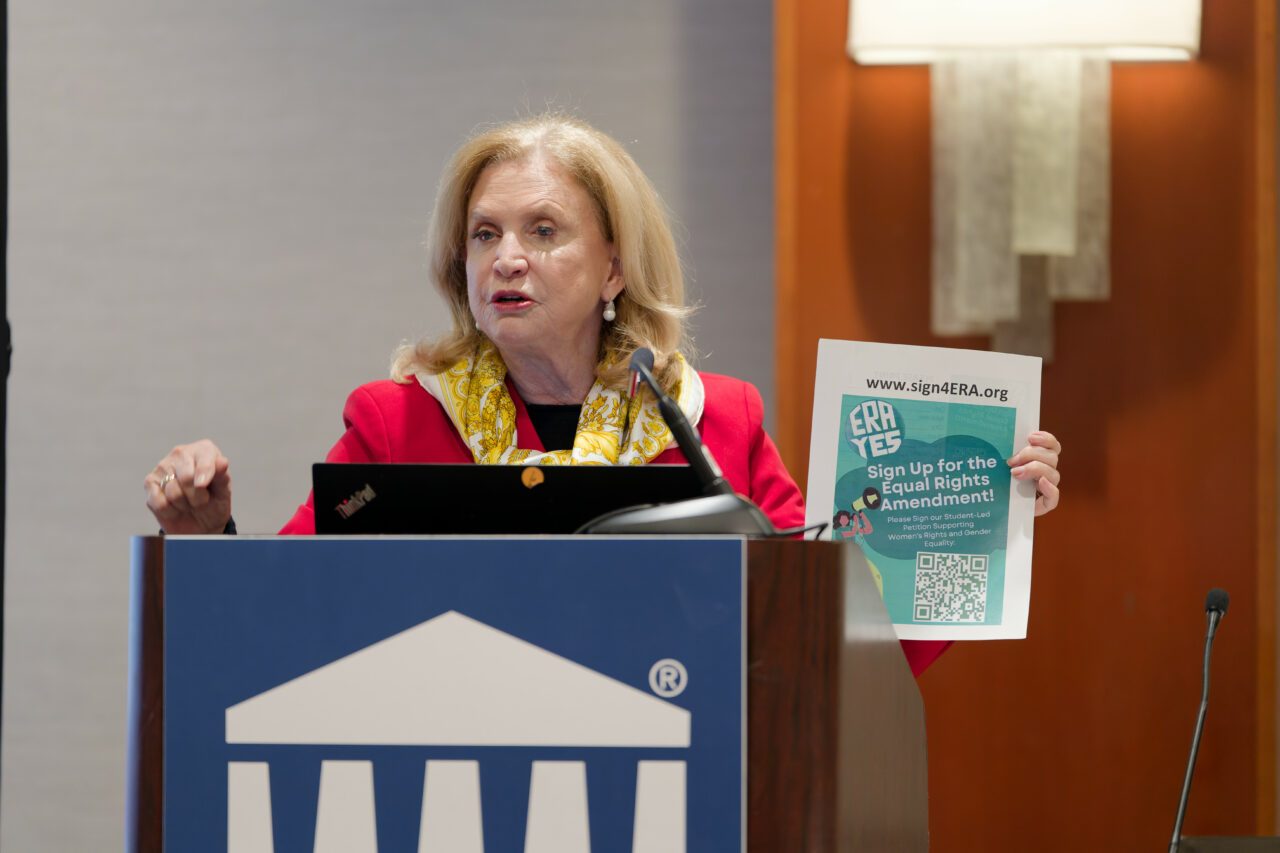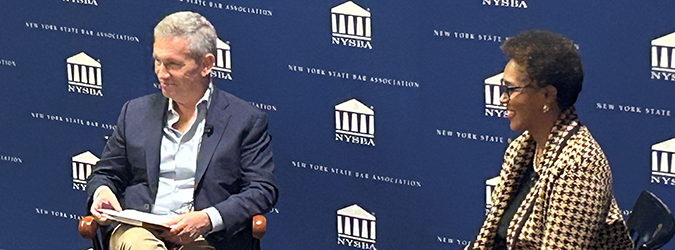Dobbs v. Jackson: Changes in U.S. Global and Domestic Leadership for Women’s Rights
3.8.2023

“In light of [the] worldwide liberalization of abortion laws, it is American States that will become international outliers after today.”[1] So concluded the dissenting United States Supreme Court Justices Breyer, Sotomayor and Kagan in their response to the majority opinion in Dobbs v. Jackson Women’s Health Organization.[2] Dobbs, issued on June 24, 2022, tumultuously overturned 50 years of precedent in abortion law set in 1973 by Roe v. Wade,[3] eliminating the constitutional protection U.S. women had from unduly restrictive state regulations during the early stages of pregnancy. This decision called into question many things – the vulnerability of the judicial branch to political influence, the equality of women under the U.S. Constitution, the impact of geography on personal choice and the power of societal institutions to control decisions about women’s bodies. Importantly, because Dobbs came from the highest court of our nation, it also called into question the ability of the U.S. to be a global leader on issues of women’s rights, including its ability to protect freedoms previously taken for granted.
This article uses the Dobbs decision to explore the United States’ international leadership role in women’s rights. It examines the United States’ past record in this area, revealing that the U.S. has not necessarily been the global leader one might assume it to be. It explores the fragmentation of leadership among states with varying laws and the resulting disparate impacts on women. Finally, the article posits that the new supporters and protectors of women’s rights might be neither state nor federal institutions.
Dobbs: An Embarrassing Clawback of Constitutional Rights
When the Supreme Court decided Roe v. Wade, it spoke with a voice of reason and balance, which is the type of voice that is easy to hold up as an example to other nations. In Roe, the Supreme Court needed to reconcile two strongly competing sets of interests: the interests of the states in protecting fetal life and the interests of women in being able to make very personal and consequential life decisions autonomously. In such cases of competing goals, the court will often strike a balance, recognizing the interests and rights of both sides and creating a middle ground to effectively pave a pathway forward. Accordingly, the interests of the states and women in Roe were blended into a functional rule balancing an individual’s right to make this personal choice during the early stages of pregnancy on one side, with the state’s right to protect fetal life in the later stages of pregnancy on the other side.
By taking into consideration the interests of women, and using those interests in formulating a decision, Roe helped strengthen the status and autonomy of women under the Constitution. At the same time, it encouraged a positive societal relationship between the federal government and women. “Like many constitutional rights, the right to choose situates a woman in relationship to others and to the government. It helps define a sphere of freedom, in which a person has the capacity to make choices free of government control.”[4] Having this sphere of freedom is important because as a general principle “we do not believe that a government controlling all private choices is compatible with a free people.”[5]
In Dobbs, the court (and specifically the conservative majority controlling the Supreme Court) presents a completely different approach. Casually throwing precedent and the doctrine of stare decisis out the window, Dobbs forgoes a balancing of interests and instead focuses solely on the interests of the states. As noted by the dissent, “[t]he Constitutional regime we enter today erases the woman’s interest and recognizes only the State’s.”[6] Dobbs denies that women have any constitutionally protected interests in this area, under the Fourteenth Amendment or otherwise, effectively collapsing the “sphere of freedom” in which women had the ability to make a private choice without government control. This collapse is devasting to women’s autonomy and equality, and it’s damaging to women’s relationships with government institutions.
Dobbs leaves open the possibility for individual states to create laws that mimic the earlier, balanced approach of Roe; however, they have no obligation to. Indeed, there is no constitutional obstacle to a state forcing a woman to bring a pregnancy to term from the moment of conception, regardless of rape, incest, viability of the fetus or medical harm to the mother. The constitutional protections of privacy and autonomy have been lost, and this loss is profound: “Whatever the exact scope of the coming laws, one result of today’s decision is certain: the curtailment of women’s rights, and of their status as free and equal citizens.”[7]
Remarkably, Dobbs arrives at its result by asserting that the 14th Amendment cannot possibly include a privacy choice involving abortion, because there was no “deeply-rooted” American tradition affording such a right in 1868 when the 14th Amendment was written. This backwards reasoning immediately endangers all progress and evolution of constitutional liberties and rights that the U.S. has made since 1868. To put this timing into context, women had no constitutional right to vote until 1920. Until 1967, states could still outlaw interracial marriage. Certainly no “deeply rooted”[8] American tradition affording a right to interracial marriage existed in 1868, so by the court’s reasoning, the Constitution should not protect this right today.
In Dobbs, the Supreme Court thus turns the U.S. Constitution into a static, stale and expressly limited document instead of an enduring declaration of liberty for other nations to admire. Global leadership arguably involves moving forward and adapting to changing circumstances over time. By this measure of leadership, the Supreme Court failed.
International Reaction to Dobbs: Distancing and Criticism
As an expression of U.S. judicial (and political) power on a global stage, Dobbs was impossible to ignore. Global leaders from the European Union and the United Nations reacted to the decision with concern and by expressing solidarity with U.S. women. It is problematic to have a country that is supposed to be a powerhouse of economic and social leadership take a “serious step backwards for women’s rights,” as stated by Norway’s prime minister and echoed by both the U.K’s prime minister and the first minister of Scotland.[9] They were joined by French President Macron who expressed his support for “the women whose liberties are being undermined by the Supreme Court of the United States,”[10] while a popular photo in the media showed French women out protesting Dobbs in solidarity with U.S. women.[11] At the same time, Belgium’s prime minister recognized that the U.S. has global influence and expressed concern about “the signal [Dobbs] sends to the world.”[12]
Perhaps the comments most damaging to the U.S.’ authority in women’s equality came from United Nations representatives. The U.N. secretary general spokesperson and the U.N. high commissioner both criticized Dobbs as running counter to the ideals of international human rights law. Their comments were particularly damaging because the United Nations is itself a global authority – one that recognizes on a global scale that every individual (regardless of nationality) deserves certain rights and freedom from certain oppressions. U.S. women may have experienced confusion in having their interests reaffirmed as a global citizen by a global authority, while having those same interests eliminated as a national citizen by a national authority. Even greater confusion ensued as each state looked to put its own rules into place, whether or not those rules were compatible with those of neighboring states. Such domestic fragmentation further jeopardizes the U.S.’ ability to be a global leader.
Was the U.S. a Global Leader of Women’s Rights Prior to Dobbs?
Some key milestones in gender history could lead one to think that the U.S was a leader of women’s rights. The Equal Pay Act of 1963 marked significant, meaningful progress, even if the goals of the act have not matched reality particularly well. In 1971, the Supreme Court’s decision in Eisenstadt v. Baird[13] determined the right of unmarried women to birth control as another stepping stone of progress. And the U.S. presents as a strong leader when contrasted with countries running much more gender-oppressive regimes.
However, a closer look at the U.S.’ gender equality record reveals that the U.S. is not at the forefront of advancement or strong leadership in this area. For example, while the goals of the Equal Pay Act remain difficult to achieve in the U.S., Iceland bolstered its equal pay laws with a requirement for all companies with at least 25 full-time employees to obtain government certification verifying equal pay practices, ensuring better compliance.[14]
The U.S.’ failure to ratify the Equal Rights Amendment is another indicator of weak women’s rights leadership. The ERA, first presented 50 years ago, would have added language to the Constitution stating that “equality of rights under the law shall not be denied or abridged by the United States or by any State on account of sex.”[15] Unfortunately, the amendment has yet to be ratified by 38 states and still is not part of the Constitution. In contrast, 85% of U.N. member states have express constitutional provisions prohibiting discrimination on the basis of sex.[16] In this respect, “the U.S. is out of step with the rest of the world to the detriment of women and girls.”[17]
The U.S. also showed weak leadership in gender equality by failing to ratify the Convention on the Elimination of Discrimination Against Women. Adopted by the U.N. in 1979, the convention aims to end discrimination against women and establish equality in various focus areas such as health care, education, employment, marriage, and political participation. “The U.S. is the only established democracy in the world that has failed to ratify CEDAW.”[18]
Additional examples are easy to find, such as the U.S.’ dubious status as one of only nine countries that do not guarantee paid leave to mothers of newborns.[19] Thus, the U.S. is not a global trailblazer for women’s equality. It is not even, necessarily, a good follower.
Dobbs and the Interstate Network Effect: Fragmentation in the Absence of Federal Leadership
When Dobbs removed federal recognition of women’s interests and left decisions to the states, it prompted women to reassess their relationships with the state authorities surrounding them, which leads to the question of how power is maintained at a national level. The ideal function of nationalism “. . . demand(s) that there be no rule of difference in the domain of the state.”[20] Ironically, this disfunction of the nation is exactly how the U.S. federal government conceded power to individual states regarding the protection of reproductive rights.
These federal and state authorities present inconsistent and competing rules that leave women in a bewildering maze of where they can find their reproductive health care interests protected. This specifically happens in the fragmented and conflicting laws between states. The disjointed, inconsistent inability for a state to protect rights based on geography is caused by a failure of federal leadership. When leadership on the national level fails, states are enabled to default to populist-driven politics.
The relational networks in the U.S. between the states can be both weak and strong; either way, there is no guarantee of leadership that promotes women’s interests. At the same time, “trans-territorial or trans-state collectivities in turn [bring] about an important repercussion, namely the development of strong tendencies to redefine boundaries of collectivities, and of new ways of combining ‘local,’ global, transnational, or trans-state components.”[21] When cultural values align between states that swing politically to the most conservative version of Republican ideals, as in Texas and Idaho, repressive law is not only passed but considered a new and normal standard, forming new ideological collectives that jump across geographical boundaries. States like Texas and Idaho form a strong network, and these states are then supported by a larger network of states having similar ideology. These networks, whether weak or strong, are derived from illusory borders that are chartered to lead their respective collectives; but networks are vulnerable to trends.
Shortly after strict state abortion laws were passed in Texas, Idaho followed to pass a total abortion ban as well. Though Texas and Idaho are not contiguous, these non-tangible borders held together by the idea of a network of laws reinforce the moral-fueled ideology of statehood. The imaginary borders are held together by collectives in networks that influence and uphold the laws in these areas, causing a gap in leadership for the vulnerable individuals within these invisible boundaries. However, state identity defined in this way can be divisive. “The effects of deeply penetrating interventions on state autonomy transcend the realm of ideology and cultural legitimation. Increased penetration of civil society by the States actives political responses and increases the likelihood that societal interests will attempt to invade and divide the state.”[22] Indeed, this division is seen within neighboring states to Idaho, like Oregon, where the network of services, particularly around abortion, had previously been transitory between state lines. For example, Idaho’s capital city, Boise, with a total population close to one million people, is no longer in a position to provide women of Eastern Oregon, who live geographically closer to the Idaho border than to urban areas in their own state, the health care they need to access.
Even with laws that protect women’s interests, the leadership of the states are not able to create equity in health care. The issue is that even at the state level, the laws of other states decide the outcomes for women in a network effect “. . . as more and more states put bans in place . . . residents are going to have to travel out of state for care.”[23] The overarching problem is that traveling out of state is what some women had to do to begin with, and now that those states have halted services, there is a backlash on state government as a capable structure to protect and preserve freedoms. The division that is apparent between states and their polarized political arguments leaves the states positioned as weak leaders, swinging one way or the other on a polarized issue, and leaving women grouped on either side of an imaginary boarder in an absence of representative leadership.
When the federal government leaves it to the states to govern based on their own disparate ideologies, many of which are dismissive of women’s interests, the collective of all states reflecting the identity of the nation has failed to maintain its position as a global leader.
Dobbs and the Rise of Corporate Leadership
With national and state leadership in fragmented disarray, a gap opened for new leadership to come forward. Corporations stepped into this gap. Mentioned in “The Rights of Man and the Rights of the Man-Made: Corporations and Human Rights,” there are “important implications of business corporations being considered as bearers of human rights for determining the proper scope and purpose of international human rights norms, and for conceptualizing their relationship to constitutional democracy.”[24] The world has seen this responsibility of bearing protection over human rights led by international corporations.
Leadership is both reactive and proactive as well as progressive and regressive. It is evident that the Supreme Court provided regressive leadership for the U.S. in its ruling excluding consideration of women’s interests. These laws concede proactive power to corporations that set standards in the private sector for proactive protection of women and their interests at the cost of a demotion in global position as a nation.
When the federal government allows states to choose to what degree interests will be protected, like the freedoms that are allowed to be dismissed in the wake of Dobbs, it is private sector corporations that lead by providing care for the people whom the states fail to protect. This was evident in the media after Dobbs. Many private companies stepped up publicly to state that they would help their employees pay travel costs associated with abortions.[25] It is ironic that “the man,” slang for an organization of power and authority, is both left to and able to provide for women in this instance of diminished freedom by state governing law, which was enabled by deflection of leadership at the national level.
Corporations like Amazon and Adidas, among dozens of other international companies, are raising the bar in terms of what support is provided to protect reproductive health. Peter McGuinness, CEO of Impossible Foods, for example, has stated that “[s]upporting our colleagues in their reproductive health is absolutely the right thing to do.”[26] As another example, Walmart has taken the lead on offering health care services to its female employees by expanding health care coverage. In addressing racial disparity in maternal care, Walmart acknowledges that in some states, distrust of the medical community puts women at risk. To this end, Walmart offers coverage for doula services for family planning in order to reach those who would otherwise be underserved and at risk when giving birth, exemplifying the care corporations can and are extending to women in their organizations.[27]
There is a limit to the reach of corporate leadership in this area, however. Unemployed women are at risk of being failed by national and state law and unable to be helped by a corporation. The list of companies that are increasing coverage for reproductive health is long, but women who have no income and cannot work for such a generous company are left as victims. The federal government fails them, the state fails them and the corporate sector that is there as an alternative leader does not have reach past the women who qualify to have their rights protected because they have employable skills.
Conclusion
The intersection of society and culture with political belief is ever-changing. As sociologist Bonilla Silva said in Social Currents, “We must become sociologically driven citizens concerned with building a more democratic, inclusive, and just society.”[28] Some sociologically driven citizens have worked to reinforce women’s interests as a meaningful response to Dobbs, resulting in encouraging progress, such as New York’s passage of the ERA in two consecutive legislative sessions, which now allows the ERA to be placed on the ballot for vote by New Yorkers during the 2024 general election.[29]
However, the idea of a “just” society is still fragmented on a state and national level leaving leadership to a sector that has the power to leverage its economic muscle for leading and protecting human rights. “In social and political contexts, we typically attribute power to agents when we hold them responsible for bringing about significant outcomes.”[30] The leadership and power to protect and bring about these significant outcomes for women in the U.S. is in some states entirely up to the organization of private sector corporations. The interstate network effects further fragmentation and decay of global leadership, which in turn signals the rest of the world that, in this respect, the U.S. has an atrophied system of governance. The international response to Dobbs sent a wave of shock and disproval for a decision that appeared reactionary and regressive for women under global standards. This was not a ruling made in a vacuum involving only the U.S.; it impacts the entire world, and with fragmentation and shifting collectives in place of leadership, the U.S. appears as “one of many countries that appear whole only on maps.”[31]
Moreover, such fragmentation leads to confusion for individuals who must reconsider what it means to be citizens of a particular state, of the United States or a global citizen, when each type of citizenship brings different levels of protection or types of affirmation. “The bond of citizenship has long been premised on the belief that states serve to protect certain socioeconomic, political, and civil rights of their citizens.”[32] This bond becomes strained when protection is inconsistent, and geography is a determining factor of whether important personal interests will be valued. State governing bodies are now allowed to independently impose law where federal leadership has failed to consider the interests of women, and international corporations have new leadership, power and opportunity to deliver solutions.
The clawback of the constitutional rights of women and the international reaction to Dobbs have both a globalized impact and a localized state impact that leaves power to corporations in the private sector, mainly for U.S.-led companies, to correct infringements on human rights. Who knew that the corporate “man” would still need to protect a woman’s decision in 2022?
Laurie S. Coles is an in-house lawyer with Paychex, Inc. who specializes in SaaS contracts, litigation, and commercial leasing. She is a 2023 candidate for the IE Brown EMBA Program. She is also a member of NYSBA’s Women in Law Section and a member of the WILS Legislative Affairs Committee.
Danielle Essma holds a bachelor of arts in performance art from Idaho State University and is a 2023 candidate for the IE Brown EMBA Program. She builds business operations for scale with Fortune 500 SaaS companies with a focus in data analytics technology, corporate strategy, and organizational transformation.
This article appears in WILS Connect, a publication of the Women in Law Section. For more information about the Women in Law Section, please visit NYSBA.ORG/WILS.
[1] Dobbs v. Jackson Women’s Health Org., 146 S. Ct. 2228, 2341, 597 U.S. __ (2022) (Breyer, Sotomayor, and Kagan, JJ., dissenting).
[2] Id.
[3] Roe v. Wade, 410 U.S. 113 (1973); see also Planned Parenthood v. Casey, 505 U.S. 833 (1992).
[4] Dobbs, 146 St. Ct. at 2345–46.
[5] Id. at 2320.
[6] Id. at 2323.
[7] Id. at 2318.
[8] Id. at 2235.
[9] Zoe Christen Jones, World Leaders React to the U.S. Supreme Court’s Decision to Overturn Roe v. Wade, CBS News (June 24, 2022).
[10] Id.
[11] Id.
[12] Id.
[13] Eisenstadt v. Baird, 405 U.S. 438 (1972).
[14] Government of Iceland, Equal Pay Certification, https://www.government.is/topics/human-rights-and-equality/equality/equal-pay-certification.
[15] Equal Rights Amendment, https://www.equalrightsamendment.org.
[16] Equality Now, When It Comes to Constitutional Equality, the United States Lags Behind the Rest of the World, Sept. 17, 2020, https://www.equalitynow.org/news_and_insights/constitutional_equality_united_states_era/.
[17] Id.
[18] Jessica Ravitz, Women in the World: Where the U.S. Falters in Quest for Equality, CNN, Apr. 16, 2015, https://www.cnn.com/2015/04/16/us/american-women-world-rankings/index.html.
[19] Id.
[20] Chatterjee, Partha, Whose Imagined Community? Millennium 20, No. 3 at 521–25 (1991).
[21] Introduction: Collective Identities, States and Globalization: Exploring the Legacy of SN Eisenstadt.
[22] The State and Economic Transformation: Toward an Analysis of the Conditions Underlying Effective Intervention, Bringing the State Back In, 44–77 (1985).
[23] Sarah McCammon, Even Before the Dobbs Ruling, More Americans Were Traveling for Abortions, NPR, July 21, 2022, https://www.npr.org/2022/07/21/1112609958/even-before-the-Dobbs-ruling-more-americans-were-traveling-for-abortions.
[24] The Rights of Man and the Rights of the Man-Made: Corporations and Human Rights, Human Rights Quarterly, Vol. 38, No. 2 (May 2016), https://www.jstor.org/stable/24738053.
[25] Kate Gibson, These Companies Are Paying for Abortion Travel, CBS News, July 2, 2022, https://www.cbsnews.com/news/abortion-travel-companies-paying-benefits-amazon-starbucks-target/.
[26] Shea Holman & Hannah Naylor, The Dobbs Decision: Emerging Trends in Corporate Response, The Purple Campaign, July 21, 2022, https://www.purplecampaign.org/purple-post/2022/7/20/the-dobbs-decision-emerging-trends-in-corporate-response.
[27] Anne D’Innocenzio, Walmart Expands Health Services to Address Racial Inequality, AP News, June 22, 2022, https://apnews.com/article/health-louisiana-indiana-race-and-ethnicity 4d31b165d3c7235f41894633f9249e1e1.
[28] Eduardo Bonilla-Silva, ‘Racists,’ ‘Class Anxieties,’ Hegemonic Racism, and Democracy in Trump’s America, Social Currents, Vol. 6(1) at 14–31 (2019), https://journals.sagepub.com/doi/pdf/10.1177/2329496518804558.
[29] See Susan DeSantis, NYSBA Calls ERA a Crucial Amendment to the State Constitution, New York State Bar Association, Jan. 24, 2023, https://nysba.org/nysba-calls-era-a-crucial-amendment-to-the-state-constitution/.
[30] Steven Lukes, Power, The American Sociological Assoc., Contexts, Vol. 6(3) at 59–61 (2007).
[31] Rana Dasgupta, The Demise of the Nation State, The Guardian, Apr.5, 2018, https://www.theguardian.com/news/2018/apr/05/demise-of-the-nation-state-rana-dasgupta.
[32] Sheila L. Croucher, Globalization and Belonging: The Politics of Identity in a Changing World, 84 (2003).






